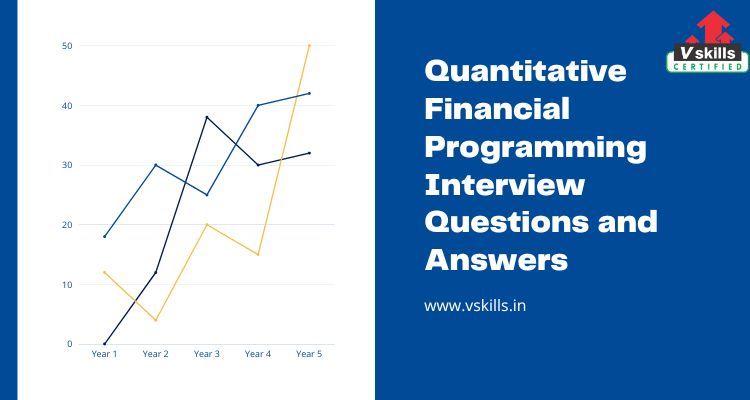Quantitative finance and algorithmic trading have witnessed tremendous growth and innovation over the years, making them highly competitive fields for both aspiring and experienced professionals. Interviews in these domains are rigorous, requiring candidates to demonstrate their technical knowledge, problem-solving abilities, and adaptability to the fast-paced environment of financial markets.
In this blog post, we will delve into the intricacies of interviews in quantitative finance and algorithmic trading, shedding light on the insights that can help you succeed and the challenges you might encounter.
Skills for Quantitative Finance and Algorithmic Trading
To excel in interviews for quantitative finance and algorithmic trading positions, candidates must possess a deep understanding of the field and showcase their skills effectively. Here are some key insights to consider:
- 1) Technical Proficiency Matters : Quantitative finance and algorithmic trading roles require a strong foundation in mathematics, statistics, programming, and financial theory. Interviewers expect candidates to demonstrate their technical proficiency in areas such as stochastic calculus, time series analysis, and data analysis.
- 2) Problem-Solving is Essential : Financial markets are dynamic, and problems faced by professionals in these fields are often complex and novel. Interviews will likely include questions that test a candidate’s problem-solving skills, such as developing trading strategies, risk management, or optimizing trading algorithms.
- 3) Market Knowledge is Crucial : Understanding financial markets and how they operate is fundamental to success in quantitative finance and algorithmic trading. Candidates should be well-versed in market microstructure, asset pricing models, and the impact of economic events on financial instruments.
- 4) Demonstrate Adaptability : Quantitative finance and algorithmic trading are evolving rapidly. Interviewers look for candidates who can adapt to new technologies, market conditions, and regulatory changes. Demonstrating your ability to stay updated and flexible in your approach is crucial.
Challenges in Quantitative Finance and Algorithmic Trading Interviews
Interviews in these fields can be particularly challenging due to the depth of knowledge and expertise required. Let’s explore some of the common challenges candidates might face:
- 1) Technical Screening : Quantitative finance and algorithmic trading interviews often begin with technical screenings. Candidates are expected to solve complex mathematical problems and coding challenges. The challenge here is to perform well under pressure, especially when tackling problems you might not have encountered before.
- 2) Domain Knowledge : Many candidates underestimate the importance of market knowledge. Without a strong understanding of financial instruments, trading strategies, and market dynamics, it can be challenging to provide insightful answers during interviews.
- 3) Algorithmic Trading Simulations : In algorithmic trading interviews, you might be asked to design and implement trading algorithms. This task can be daunting, especially if you’re given a limited amount of time. You must demonstrate your ability to create algorithms that are both profitable and risk-controlled.
- 4) Behavioural Questions : Behavioural questions are often used to assess a candidate’s ability to work in a team, handle stress, and make ethical decisions. Answering these questions effectively can be challenging, especially if you have limited work experience in the field.
- 5) System Design : System design questions in algorithmic trading interviews involve designing a trading system from scratch. This encompasses everything from data acquisition to order execution. Candidates must showcase their comprehensive understanding of the entire trading process, including risk management and backtesting.
Strategies for Quantitative Finance and Algorithmic Trading Interviews
Now that we’ve explored the insights and challenges, it’s crucial to discuss strategies to overcome these challenges and perform well in quantitative finance and algorithmic trading interviews:
1. Preparation is Key : Adequate preparation is essential. Study core concepts in quantitative finance, algorithmic trading, and relevant programming languages. Practice solving technical problems and simulate algorithmic trading scenarios.
2. Leverage Online Resources : There are numerous online resources, such as books, courses, and forums, that can help you prepare. These resources offer insights, sample questions, and explanations to deepen your knowledge.
3. Conduct Mock Interviews : Mock interviews with mentors or peers can help you become more comfortable with the interview format. They provide an opportunity to receive feedback and improve your responses.
4. Stay Informed : Quantitative finance and algorithmic trading are continually evolving fields. Stay up to date with industry news, research, and technological advancements to demonstrate your adaptability during interviews.
5. Highlight Transferable Skills : If you lack direct experience in quantitative finance or algorithmic trading, emphasise transferable skills. For example, discuss how your problem-solving abilities, mathematical acumen, or programming skills can be applied to the role.
Algorithmic Trading Strategies Interview Questions
Case Study: Imagine you are a quantitative trader working for a hedge fund. Your goal is to design an algorithmic trading strategy for a stock, ABC Inc. The stock exhibits high volatility, and you believe there are opportunities for profit. You have access to historical data and real-time market data feeds. Your objective is to create a strategy that maximises returns while managing risk effectively.
Question 1: Which of the following types of algorithmic trading strategies would be most suitable for capitalising on the stock’s high volatility?
Explanation 1: In the context of high volatility, momentum strategies are often used. These strategies aim to capitalise on the continuation of trends. In this case, you would be looking to profit from the stock’s price movements in the direction of its current trend.
Question 2: To execute a momentum strategy effectively, which of the following data sources is the most crucial?
Answer 2: A. Historical price data
Explanation 2: Historical price data is essential for analysing and identifying trends. It helps in determining the stock’s past price behaviour, which is critical for a momentum strategy.
Question 3: How can you manage risk in algorithmic trading?
D. Trade only during high volatility periods
Answer 3: B. Use stop-loss orders
Explanation 3: Stop-loss orders are a key risk management tool. They automatically trigger a sale when the stock’s price reaches a predefined level, limiting potential losses.
Question 4: Which market impact costs are associated with algorithmic trading?
Explanation 4: Bid-ask spread is a cost associated with executing trades. Algorithmic traders need to consider it, as narrower spreads are preferable for reducing trading costs.
Question 5: What is the primary objective of slippage control in algorithmic trading?
Answer 5: C. Avoiding market impact
Explanation 5: Slippage control aims to reduce the market impact of a trade, which can adversely affect the stock’s price. By minimising market impact, the objective is to avoid moving the market against your position and ensuring efficient execution.
This case study and the accompanying multiple-choice questions provide insights into the candidate’s knowledge of algorithmic trading strategies in the context of quantitative finance. A strong understanding of the types of strategies, the importance of data sources, risk management, market impact costs, and slippage control is crucial for success in such a role. These questions help assess the candidate’s readiness for a position in this field by evaluating their decision-making and knowledge application skills.
Quantitative Modelling Interview Questions
Case Study : You are working as a quantitative analyst at a hedge fund specialising in algorithmic trading. Your team is developing a new trading strategy for a currency pair, EUR/USD. The objective is to create a quantitative model that accurately predicts short-term price movements and enables profitable trading opportunities. You have access to historical price data, order book data, and macroeconomic indicators.
Question 1: What is the primary purpose of quantitative modelling in algorithmic trading?
B. Reducing the impact of market news
C. Predicting future price movements
D. Speeding up order execution
Answer 1: C. Predicting future price movements
Explanation 1: The primary goal of quantitative modelling in algorithmic trading is to develop models that can predict future price movements, allowing traders to make informed decisions.
Question 2: Which type of data is most relevant for developing a quantitative model for currency trading in this case?
Explanation 2: Order book data provides insights into the supply and demand dynamics of the market and is crucial for modelling currency pair movements.
Question 3: What type of quantitative model would be most suitable for short-term trading of currency pairs?
A. GARCH (Generalised Autoregressive Conditional Heteroskedasticity)
D. Multinomial logistic regression
Answer 3: D. Multinomial logistic regression
Explanation 3: Multinomial logistic regression is often used for predicting the direction of currency pair movements in the short term.
Question 4: What is the primary benefit of backtesting quantitative models?
A. Predicting future market conditions
B. Demonstrating model performance
C. Automating trading decisions
Answer 4: B. Demonstrating model performance
Explanation 4: Backtesting is used to assess how well a quantitative model would have performed in historical market conditions, demonstrating its performance.
Question 5: In the context of algorithmic trading, what is the role of risk management?
A. Maximising trading frequency
B. Avoiding regulatory compliance
D. Protecting capital from losses
Answer 5: D. Protecting capital from losses
Explanation 5: Risk management in algorithmic trading focuses on protecting capital from excessive losses and ensuring the long-term viability of the trading strategy.
This case study and the accompanying multiple-choice questions provide a comprehensive assessment of the candidate’s knowledge of quantitative modelling in the context of quantitative finance and algorithmic trading. The questions cover the purpose of quantitative modelling, relevant data sources, model selection, backtesting, and the role of risk management. These topics are essential for any candidate aspiring to work in quantitative finance and algorithmic trading roles, and the questions help evaluate their understanding and decision-making abilities in these areas.
Ethical Considerations in High-Frequency Trading Interview Questions
Case Study : You are a risk manager at a prominent investment firm that utilises high-frequency trading strategies. The firm’s HFT algorithms have been successful, but there have been concerns raised about the ethics of HFT practices. Some critics argue that HFT can create market instability and unfair advantages for large firms. Your team is exploring the ethical implications and considering whether any changes are necessary to align the firm’s practices with ethical standards.
Question 1: What is a significant ethical concern associated with high-frequency trading?
A. Promoting market transparency
C. Ensuring equal access to market data
D. Creating market instability
Answer 1: D. Creating market instability
Explanation 1: High-frequency trading can contribute to market instability, leading to concerns about its ethical implications. Rapid and large-scale trading can exacerbate market fluctuations.
Question 2: As a risk manager, what measures can you take to address ethical concerns in HFT?
C. Prioritise profit maximisation
D. Ignore ethical considerations
Answer 2: B. Implement circuit breakers
Explanation 2: Implementing circuit breakers is a risk management measure that can help address ethical concerns by preventing excessive volatility and market disruptions caused by HFT.
Question 3: What is the ethical responsibility of a financial institution engaged in high-frequency trading?
A. Maximising profits at all costs
B. Ensuring equal access to market data
C. Providing preferential treatment to certain clients
D. Maintaining secrecy about trading strategies
Answer 3: B. Ensuring equal access to market data
Explanation 3: Financial institutions engaged in HFT have an ethical responsibility to ensure equal access to market data, promoting fairness and transparency.
Question 4: How can high-frequency trading firms contribute to market ethics and transparency?
A. By executing secretive, proprietary trading strategies
B. By disclosing their trading algorithms to competitors
C. By participating in regulatory discussions and transparency initiatives
D. By prioritising high-frequency trading over long-term investments
Answer 4: C. By participating in regulatory discussions and transparency initiatives
Explanation 4: High-frequency trading firms can enhance market ethics and transparency by actively engaging in regulatory discussions and supporting initiatives that promote openness in their industry.
Question 5: Why is it important for financial professionals to consider ethical considerations in high-frequency trading?
A. To maximise short-term profits
B. To comply with legal requirements
C. To ensure long-term sustainability
Answer 5: C. To ensure long-term sustainability
Explanation 5: Ethical considerations in high-frequency trading are important for long-term sustainability, as practices that align with ethical standards are more likely to build trust with clients, regulators, and the public.
This case study and the accompanying multiple-choice questions provide a thorough assessment of the candidate’s knowledge and views on the ethical considerations surrounding high-frequency trading in the context of quantitative finance and algorithmic trading. The questions cover ethical concerns, risk management, ethical responsibilities, contributions to market ethics, and the importance of ethical considerations in HFT. These topics are essential for any candidate aspiring to work in roles related to quantitative finance and algorithmic trading, and the questions help evaluate their understanding and ethical perspective in this context.




